9-й Международный симпозиум по электромагнитной совместимости и электромагнитной экологии
Подождите немного. Документ загружается.


431
EXPERIMENTAL INVESTIGATIONS OF POSSIBLE CHARACTER AND
INTENSITY OF THUNDERCLOUDS AND LIGHTING DISCHARGES
AFFECTION ON RADIO NAVIGATION EQUIPMENT SITUATED INSIDE
AIRCRAFT NOSE RADOMES ON MODELS USING ARTIFICIAL
CHARGED AEROSOL CLOUDS
A.
G.
T
EMNIKOV
,
R
USSIA
,
L.
L.
C
HERNENSKY
,
R
USSIA
,
A.
V.
O
RLOV
,
R
USSIA
,
S.
S.
A
NTONENKO
,
R
USSIA
,
T.
K.
G
ERASTENOK
,
R
USSIA
Moscow Power Engineering Institute (Technical University), TemnikovAG@mpei.ru
Results of the experimental investigations of the
discharge formation in models of aircraft nose radomes
under an action of the artificial clouds of negatively
strongly charged water aerosol for the different variants
of its lightning protection are presented in a paper.
Metal spherical electrode and plane electrode of
rectangular and round forms have been used as radar
antenna model.
Two main sequences of the discharge formation in a
radome model and the corresponding forms of discharge
current impulses from an antenna model under nose
radome are found. Their characteristics significantly
depend on the charge value stored on the radome cover
surfaces.
Phenomenology of discharge development in the
gap “cloud of charged aerosol – model of the nose
radome with antenna model inside it” significantly
depends on the charged value that accumulates on the
radome cover surfaces. For the case of simultaneous
precipitation of charged particles on the internal and
external radome cover surfaces, very big charges could
be accumulated in radome.
For storage of extreme charges of hundreds of
µC/m
2
, intense surface discharges are formed and
powerful impulses of “reverse” discharge current on the
antenna model are observed. It was established that
formation of such negative discharge from antenna
model under radome which has the polarity of the
charged aerosol cloud and current amplitude and flowing
charge much more than for positive discharges from
electrode near cloud without radome is connected with
the storage of the charges on the internal and external
surfaces of radome models.
Value of these surface charges will be limited only
by the electric strength of the aircraft nose radome cover
and/or by the formation of spark discharges on their
surfaces. If external electric field inside radome will
quickly decrease because of discharge formation from
the charged cloud or, that more possible, due to the
discharge on the external surface of radome cover, the
resulting strength of electric field changes its direction in
the place where antenna radome is situated. As a result,
“reverse” discharges with have the same sign as charged
aerosol cloud (thundercloud) appear from antenna under
radome. They have current amplitudes up to some
hundreds of amperes and could destroy the radio
navigation equipment if the lightning discharge affection
of nose radome is absent.
Such powerful impulse of discharge current on
antenna model under radome is registered in 90 % cases
when radome model does not have lighting diverters, in
30-50 % cases when segmented lightning diverters are
imitated, and very rarely observed when radome is
protected with the bar lightning diverters.
For the last case two variant of discharge
development inside radome are possible: (1) discharge
formation inside radome is initiated by the discharge
between cloud and bar electrode on the external surface of
radome model and corresponded by the propagation of the
discharges on the external surface of radome; (2)
discharge formation inside radome “provokes” the
following development of discharges between cloud and
lightning diverter on the external surface of radome cover.
Impulse of “reverse” discharge current also forms
on the antenna model however it significantly weak on
its characteristics than the considered above powerful
current impulse. Such less powerful impulse of discharge
current on the antenna model under radome is registered
in 80 % cases when bar lightning diverters protects
radome. It is characteristic in 35 % cases when
segmented lightning diverters are imitated.
Thus, it was established that presence of the bar
lightning protectors on the radome surface significantly
decreases a probability of formation of powerful
discharges from the antenna inside it and discharges on
the external and internal surface of the radome model.
For such organization of radome lightning protection,
charge of less value will be accumulated on the radome
cover surfaces than in other considered variants of
aircraft nose radome lightning protection.
As a result, charge accumulated on radome surface
will play a fewer role in the formation discharge current
impulse on the antenna model under radome and on the
contrary discharge between cloud and lightning diverter
model will bring more sufficient influence to bear on
antenna.

432
ИССЛЕДОВАНИЯ ВОЗМОЖНОГО СПЕКТРА ЭЛЕКТРОМАГНИТНЫХ
ПОМЕХ В РАДИОНАВИГАЦИОННОМ ОБОРУДОВАНИИ,
НАХОДЯЩЕМСЯ ВНУТРИ НОСОВОГО ОБТЕКАТЕЛЯ САМОЛЕТА,
ПРИ ВОЗДЕЙСТВИИ ИСКУССТВЕННОГО ЗАРЯЖЕННОГО
АЭРОЗОЛЬНОГО ОБЛАКА И РАЗРЯДОВ ИЗ НЕГО
А.
Г.
Т
ЕМНИКОВ
,
Р
ОССИЯ
,
М.
З.
Г
ИЛЯЗОВ
,
Р
ОССИЯ
,
Д.
А.
М
АТВЕЕВ
,
Р
ОССИЯ
,
А.
Ю.
В
ОРОНКОВА
,
Р
ОССИЯ
,
Л.
Л.
Ч
ЕРНЕНСКИЙ
,
Р
ОССИЯ
,
А.
В.
О
РЛОВ
,
Р
ОССИЯ
ГОУ ВПО «Московский Энергетический Институт (Технический Университет)», TemnikovAG@mpei.ru
Аннотация. Представляются результаты экспериментального исследований спектров электромагнитных
наводок на модели антенны радара самолета, возникающих при разрядах из искусственного облака заря-
женного водного аэрозоля. Установлено, что среди различных вариантов молниезащиты носового обтека-
теля при вертикальных полосовых молниеотводах на поверхности модели обтекателя максимальное зна-
чение спектральной плотности сигнала на антенне является наименьшим. Найдено, что максимальные ха-
рактерные частоты для сигналов на модели антенны сферической формы в несколько раз меньше макси-
мальных характерных частот сигналов на моделях молниеотводов. Для плоских моделей антенн в форме
диска или прямоугольника установлена обратная взаимосвязь. Предположено, что существенную роль в
характеристиках спектра электромагнитных помех на антенне радара играют токи разрядов, формирую-
щиеся за счет зарядов, осевших на поверхности обтекателя.
Abstract. The results of experimental research on the models of electromagnetic interference spectrums of
the aircraft radar antenna that occur under the discharges from artificial cloud of charged water aerosol are
presented. It was established that among different variants of nose radome lightning protection vertical bar
lightning diverters situated on the surface of nose radome model provide the minimal value of signal spectral
density on the antenna. It was found that the highest characteristic frequencies of signals on the sphere an-
tenna model are several times smaller than that of signals on the lightning diverter models. For plane disk
and rectangle antenna models the inverse relation was established. It was supposed that currents of dis-
charges formed due to charges settled on the radome surface play the essential role in the spectrum charac-
teristics of the electromagnetic interference on the radar antenna.
Введение
Погодные радары являются неотъемлемой ча-
стью современных самолетов. Радар отвечает за на-
вигацию и тем самым определяет безопасность по-
лета. Носовые радиопрозрачные обтекатели самоле-
тов предназначены для защиты антенных систем ра-
диолокационных станций от воздействия окружаю-
щей среды в условиях полета. Разряды молнии в но-
совой обтекатель самолета являются одной из основ-
ных причин появления значительных электромаг-
нитных наводок на антенне радара, способных при-
вести к его повреждению и выходу из строя [1]. Для
защиты носового обтекателя и находящегося под
ним радара от прямых ударов молнии используются
молниеотводы, от косвенных электромагнитных воз-
действий молнии применяются частотно-
избирательные защитные цепи, «фильтрующие» ха-
рактерные наведенные частоты. Таким образом, ис-
следование спектра возможных электромагнитных
наводок на антенне радара при воздействии разрядов
из грозовых облаков является задачей, без решения
которой невозможен выбор оптимальных параметров
частотно-избирательных защитных цепей.
Смоделировать численно весь спектр возмож-
ных воздействий грозовых облаков и молнии на ус-
тановленный в носовом обтекателе радар сейчас не
представляется возможным из-за большого числа
влияющих факторов [2, 3]. И полезным может ока-
заться оценка такого воздействия на основе экспери-
ментального исследования на моделях спектров
электромагнитных помех (токов) на модели антенны
погодного радара, возникающих при разрядах из ис-
кусственного облака заряженного водного аэрозоля.
Исследования возможного спектра электро-
магнитных помех
При исследовании спектров электромагнитных
помех анализировались полученные при эксперимен-
тальных исследованиях серии осциллограмм токов,
зарегистрированных на модели антенны при разрядах
из облака заряженного аэрозоля в модель носового
обтекателя самолета при различных конфигурациях
модельной системы «обтекатель – молниеотводы –
антенна». Параметры создаваемого заряженного аэ-
розольного облака, измерительного комплекса для
регистрации электрических и оптических характери-
стик разрядных процессов в промежутке «заряжен-
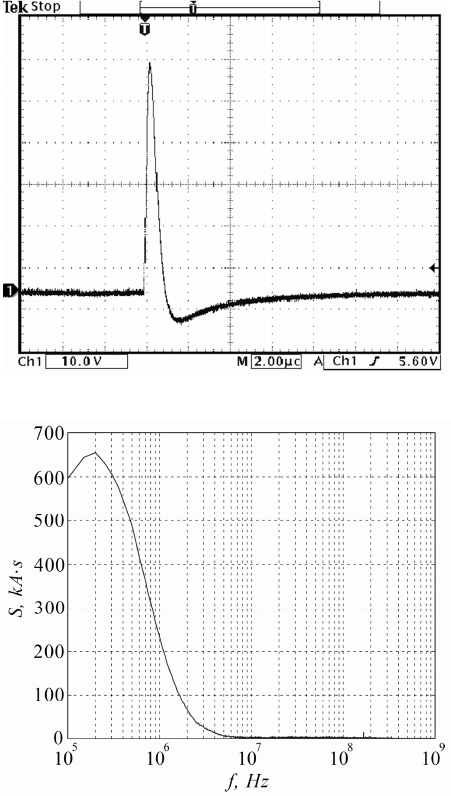
433
ное аэрозольное облако – модель носового обтекате-
ля с электродом внутри» и типичная картина форми-
рования разряда из облака заряженного аэрозоля в
модель обтекателя представлены в [4-6].
В качестве моделей радиопрозрачных носовых
обтекателей использовались тонкостенные полые
диэлектрические элементы полусферической формы
из полиметилметакрилата и в форме параболоида
вращения из полиэтилентерефталата с разным внут-
ренним объемом. В качестве модели, находящейся
под обтекателем антенны, использовались сфериче-
ский электрод диаметром 24 mm и плоские электро-
ды круглой или прямоугольной формы площадью от
75 cm
2
до 2000 cm
2
. В ходе проведенных экспери-
ментальных исследований рассматривались следую-
щие варианты расположения и формы моделей мол-
ниеотводов на поверхности модели носового обтека-
теля: I – без присутствия моделей молниеотводов на
поверхности модели обтекателя; II – с кольцевыми
полосовыми электродами на внешней и внутренней
поверхности обтекателя, моделирующими металли-
ческую часть фюзеляжа, примыкающую к носовому
обтекателю самолета; III – с моделями вертикальных
полосовых молниеотводов на внешней и/или внут-
ренней поверхности модели обтекателя.
Для каждой конфигурации модели системы «об-
текатель – антенна – молниеотводы» была проведена
серия опытов из не менее чем тридцати подходов и
был получен набор осциллограмм, представляющих
собой временную развертку токов, регистрируемых
на антенне радара и молниеотводах на внешней и
внутренней поверхности модели обтекателя. Элек-
трические характеристики разрядов, возникающих в
результате взаимодействия модели обтекателя и ан-
тенны с заряженным облаком аэрозоля, в значитель-
ной мере определяют возможный уровень воздейст-
вия на электронное оборудование радара и, соответ-
ственно, на вероятность выхода его строя. Типичные
осциллограммы сигналов, регистрируемых на моде-
ли антенны и моделях молниеотводов на поверхно-
сти модели обтекателя, показаны для вариантов I, II
и III расположения и формы моделей молниеотводов
на поверхности модели обтекателя на рис. 1a, рис. 2a
и рис. 3a, соответственно.
Для каждого сигнала, регистрируемого на моде-
лях антенны и молниеотводов, был проведен спек-
тральный анализ - с помощью дискретного прямого
преобразования Фурье [7] были определены харак-
терные частоты сигналов и соответствующие им
значения спектральных плотностей. Типичные спек-
трограммы, полученные при обработке осцилло-
грамм, приведенных на рис. 1a-3a, показаны на рис.
1b-3b, соответственно.
a)
b)
Рис. 1. Для варианта без присутствия моделей мол-
ниеотводов на поверхности модели обтекателя:
a – характерная осциллограмма тока, регистрируемая
на модели антенны (шунт 0,53 Ом);
b – соответствующая спектрограмма.
Для вариантов I, II и III организации молниеза-
щиты носового обтекателя рассчитывались макси-
мальное значение спектральной плотности сигналов
и соответствующее ей значение частоты.
Полученные результаты обобщены в таблице I.
При вертикальных полосовых молниеотводах на
поверхности модели носового радиопрозрачного
обтекателя максимальное значение спектральной
плотности сигнала S
max
на модели антенны сущест-
венно ниже, чем при наличии кольцевых электродов
на поверхности обтекателя (~ в 5-25 раз) и тем более
при отсутствии каких-либо проводящих элементов
на поверхности оболочки обтекателя (~ в 85-90 раз).
В то же время соответствующие им характерные
частоты f
Smax
, наоборот, выше.
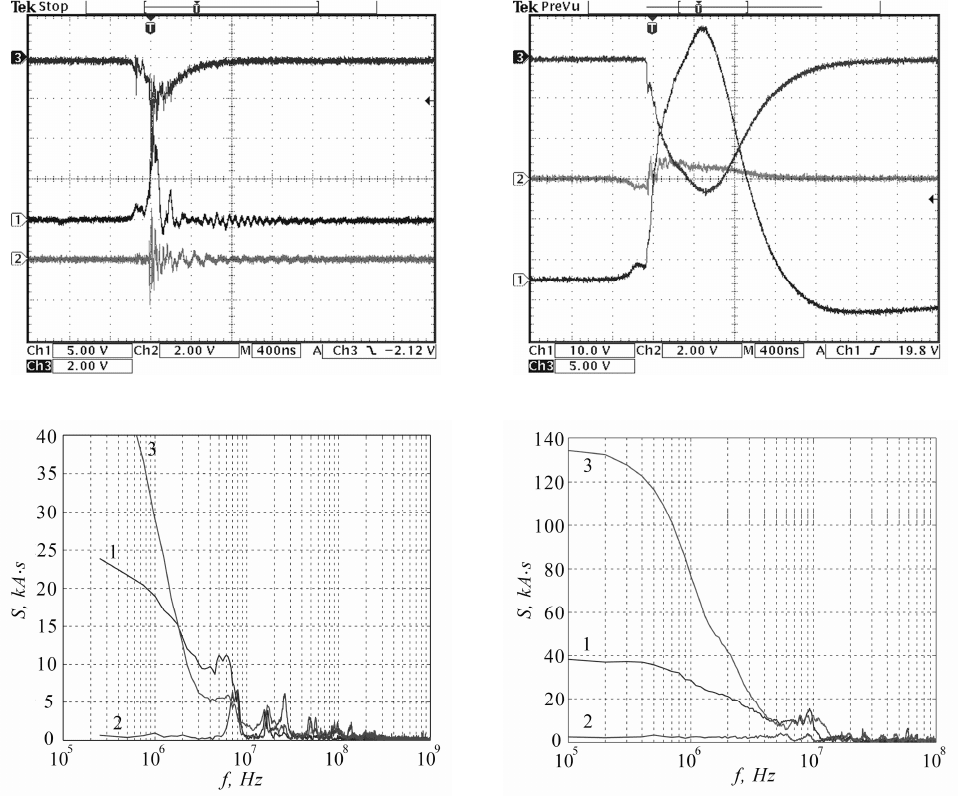
434
a)
b)
Рис. 2. Для варианта II: a – характерные осцилло-
граммы токов, регистрируемые на модели антенны
(1, шунт 0,53 Ом), электрода на внутренней поверх-
ности (2, шунт 0,13 Ом) и электрода на внешней по-
верхности (3, шунт 0,14 Ом);
b – соответствующие спектрограммы (1 – для антен-
ны, 2 – для электрода на внутренней поверхности, 3
– для электрода на внешней поверхности).
Та же тенденция наблюдается и для сигналов на
моделях молниеотводов. Это может быть связано с
тем, что в регистрируемых на модели антенны при
разрядах из облака заряженного аэрозоля токах при
наличии вертикальных полосовых молниеотводов
уменьшается доля тока проводимости. Как показано
в [5, 6], значение тока проводимости в значительной
мере определяется количеством заряда, осевшего на
поверхности обтекателя, и формированием поверх-
ностных разрядов. Именно эти поверхностные раз-
ряды дают определяющий вклад в формирование
импульса разрядного тока как на модели антенны,
так и на моделях молниеотводов, находящихся на
поверхности обтекателя.
a)
b)
Рис. 3. Для варианта III: a – характерные осцилло-
граммы токов, регистрируемые на модели антенны
(1, шунт 0,53 Ом), электрода на внутренней поверх-
ности (2, шунт 0,13 Ом) и электрода на внешней по-
верхности (3, шунт 0,14 Ом);
b – соответствующие спектрограммы (1 – для антен-
ны, 2 – для электрода на внутренней поверхности, 3
– для электрода на внешней поверхности).
При вертикальных полосовых молниеотводах в
сигнале, регистрируемом на моделях антенны и мол-
ниеотводов, преобладающую роль играют токи сме-
щения, наводимые на ней при быстром изменении
заряда облака и формировании главной стадии раз-
ряда между облаком и молниеотводами. В результа-
те, максимальные характерные частоты в спектре
сигнала для случая вертикальных полосовых мол-
ниеотводов в 2–4 раза больше, чем при наличии
кольцевых электродов на поверхности оболочки об-
текателя, когда существенную роль играют токи
проводимости разрядов, формирующиеся за счет
зарядов, осевших на поверхности обтекателя (Табли-
ца II).
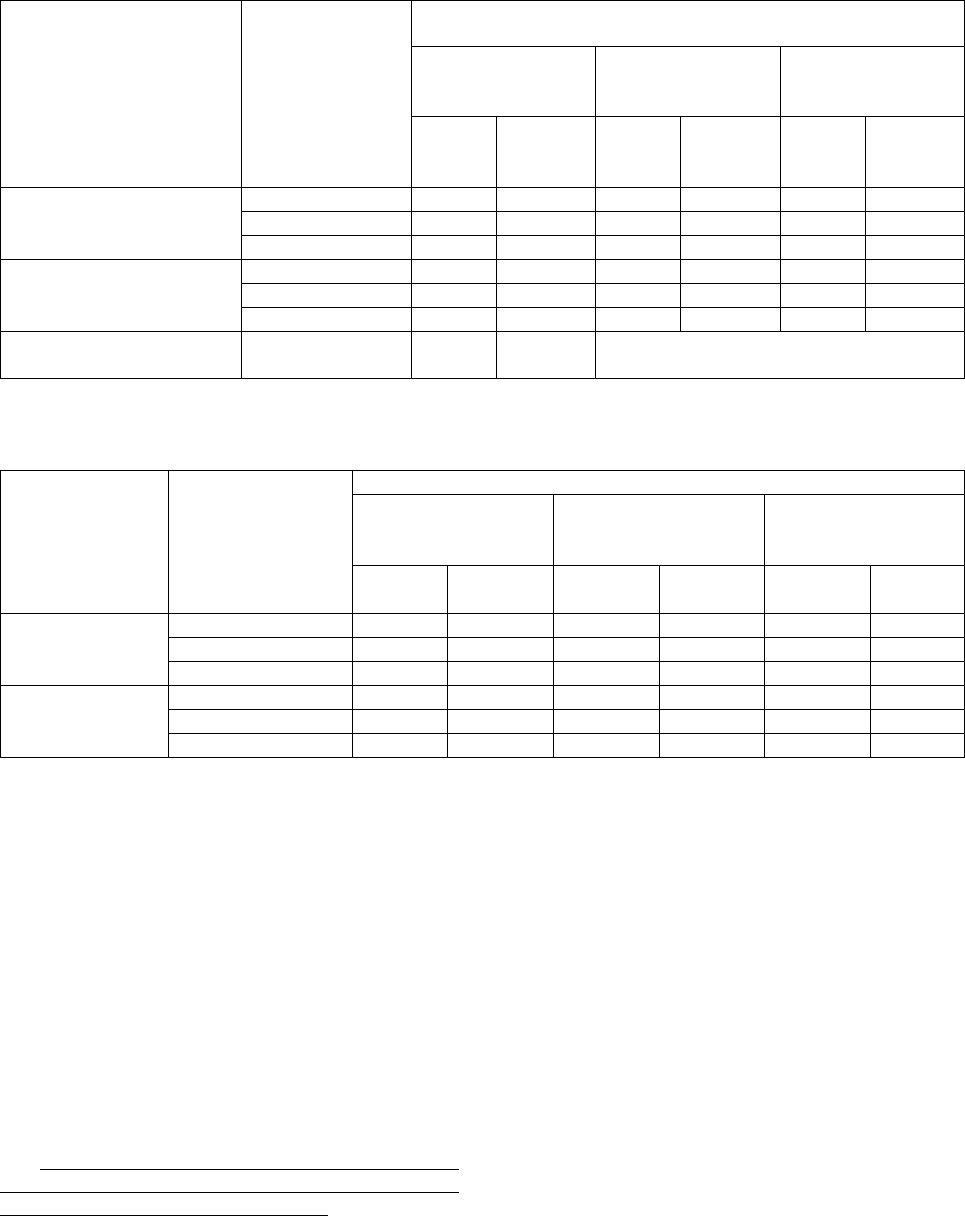
435
Таблица I
Максимальные значения спектральной плотности сигналов с антенны и с моделей молниеотводов на поверхно-
сти обтекателя и соответствующие им значения частоты при различных вариантах молниезащиты
Максимальные значения спектральной плотности сигналов и
соответствующие им значения частоты
Антенна
Молниеотвод на
внешней поверх-
ности
Молниеотвод на
внутренней по-
верхности
Вид моделей
молниеотводов
Форма
антенны
max
,
S
kA s
⋅
,
max
S
f
MHz
max
,
S
kA s
⋅
,
max
S
f
MHz
max
,
S
kA s
⋅
,
max
S
f
MHz
Диск
11 0,4 2,4 0,5 2,3 8
Прямоугольник
11,3 7,3 2,9 7 2,1 6,4
Вертикальные
полосовые
электроды
Сфера
12 1,8 31 0,2 10 8
Диск
280 0,1 240 0,05 40 0,2
Прямоугольник
320 0,07 120 0,5 28 0,2
Кольцевые
электроды
Сфера
50 2 110 1,2 60 1,2
Без
поверхностных
элек
-
тродов
Сфера
1030 0,2 –
Таблица
II
Диапазоны
значений
характерных
частот
спектров
сигналов
,
регистрируемых
на
модели
антенны
и
на
моделях
молниеотводов
на
внешней
и
внутренней
поверхности
обтекателя
Диапазон
значений
характерных
частот
,
MHz
Антенна
Молниеотвод
на
внешней
поверхности
обтекателя
Молниеотвод
на
внутренней
поверх
-
ности
Вид
моделей
молниеотводов
Форма
антенны
min
f
max
f
min
f
max
f
min
f
max
f
Диск
0,4 80 0,5 27 6 25
Прямоугольник
1,3 78 1,5 28 6 27
Вертикальные
полосовые
электроды
Сфера
0,5 40 0,2 150 5,8 140
Диск
0,04 25 0,02 7,2 0,02 8
Прямоугольник
0,07 28 0,02 8,6 0,02 8
Кольцевые
электроды
Сфера
0,4 18 1,2 95 1,2 60
По
этой
же
причине
максимальные
характерные
частоты
для
сигналов
на
модели
антенны
сфериче
-
ской
формы
,
в
3–5
раз
меньше
максимальных
харак
-
терных
частот
сигналов
на
моделях
молниеотводов
.
Для
плоских
моделей
антенн
наблюдается
обратная
тенденция
:
максимальные
характерные
частоты
сиг
-
налов
на
модели
антенны
в
несколько
раза
больше
максимальных
характерных
частот
сигналов
на
мо
-
делях
молниеотводов
.
Полученные
результаты
исследования
спектров
электромагнитных
наводок
на
модели
антенны
при
воздействии
искусственного
облака
заряженного
вод
-
ного
аэрозоля
могут
быть
использованы
как
при
вы
-
боре
оптимальной
конфигурации
системы
«
обтека
-
тель
-
молниеотводы
-
антенна
»,
так
и
при
выборе
параметров
частотно
-
избирательных
защитных
цепей
.
Работа
выполнена
в
рамках
реализации
ФЦП
«
Научные
и
научно
–
педагогические
кадры
иннова
-
ционной
России
»
на
2009 - 2013
годы
(
государствен
-
ный
контракт
№
П
1117).
Литература
1.
Н
.
В
.
Балюк
,
Л
.
Н
.
Кечиев
,
П
.
В
.
Степанов
.
Мощный
электромагнитный
импульс
:
воздействие
на
электронные
средства
и
методы
защиты
.
М
.:
ООО
«
Группа
ИДТ
», 2009.
2. Uman M.A., Rakov V.A. // Progress in Aero-
space Sciences. 2003. V. 39. P. 61-81.
3. Hall A. // Thunderstorm Protection of Aircraft
Radomes. Proc. of the Intern. Conference on Lightning
and Static Electricity. Seattle, USA, 2005. P. 118.
4.
Темников
А
.
Г
.,
Орлов
А
.
В
.,
Болотов
В
.
Н
.,
Ткач
Ю
.
В
. //
ЖТФ
. 2005.
Т
. 75.
Вып
. 7.
С
. 52-59.
5.
Темников
А
.
Г
.,
Черненский
Л
.
Л
.,
Орлов
А
.
В
.,
Полякова
О
.
В
. //
Письма
в
ЖТФ
. 2010.
Т
. 36.
Вып
.
18.
С
. 40-47.
6.
Темников
А
.
Г
.,
Черненский
Л
.
Л
.,
Орлов
А
.
В
.,
Полякова
О
.
В
. //
Труды
2
Российской
конференции
по
молниезащите
.
Москва
. 2010.
С
. 4.5.
7.
Э
.
Лэй
.
Цифровая
обработка
сигналов
дли
инженеров
и
технических
специалистов
.
М
.:
Группа
ИДТ
, 2007.

436
INVESTIGATIONS OF POSSIBLE SPECTRUM OF ELECTROMAGNETIC
DISTURBANCES IN RADIO NAVIGATION EQUIPMENT INSIDE
AIRCRAFT NOSE RADOME UNDER AFFECTION OF THE ARTIFICIAL
CHARGED AEROSOL CLOUD AND DISCHARGES FROM IT
A.
G.
T
EMNIKOV
,
R
USSIA
,
M.
Z.
G
ILYAZOV
,
R
USSIA
,
D.
A.
M
ATVEEV
,
R
USSIA
,
A.
Y
U
.
V
ORONKOVA
,
R
USSIA
,
L.
L.
C
HERNENSKY
,
R
USSIA
,
A.
V.
O
RLOV
,
R
USSIA
Moscow Power Engineering Institute (Technical University), TemnikovAG@mpei.ru
The results of experimental research on the models
of electromagnetic interference spectrums of the aircraft
radar antenna that occur under the discharges from artifi-
cial cloud of charged water aerosol are presented. Metal
spherical electrode and plane electrode of rectangular
and round forms have been used as radar antenna model.
The following variants of disposition and forms of
lightning diverter models on the external and internal
surface of nose radome model are considered in carried
out experimental investigations and in calculations: I –
without lighting diverter models on the surface of ra-
dome model; II – with ring electrodes on the internal and
external surface of radome model that could simulate the
metal part of fuselage adjacent to aircraft nose radome;
III – with vertical bar lightning diverters models on the
external and/or internal surface of radome model.
Electrical characteristics of spark discharges occur-
ring due to interaction of radome and antenna models
with charged aerosol cloud significantly determine a
possible level of action to electronic equipment of radar
and correspondingly a probability of its damage.
Spectral analysis was carried out for every electrical
signal registered on models of antenna and lightning
diverters. Characteristic frequencies of signals and corre-
sponding values of spectral densities were determined
using direct Fourier transformation.
Maximal value of spectral density of signals and
corresponding value of frequency have been calculated
for variants I, II, and III of nose radome lighting protec-
tion organization.
It was established that among different variants of
nose radome lightning protection vertical bar lightning
diverters situated on the external surface of nose radome
model provide the minimal value of signal spectral density
on the antenna model. Maximal value of spectral density
in this case is in 5-25 times less than for the case with ring
electrodes on the internal and external surface of radome,
and in 85-90 times less than for the case without lighting
diverter models on the surface of radome model.
Such tendency is observed for signals on the light-
ning diverter models too. That could be connected with
the fact that part of current conductivity in signals regis-
tered on antenna model for discharges from charged aer-
osol cloud under presence of vertical bar lightning di-
verters decreases.
Value of the conductivity current is considerably
determined by the quantity of charge precipitated on the
external and internal surfaces of radome cover and by
the forming of surface discharges. Just these powerful
surface discharges give main contribution to the forma-
tion of discharge current impulse as on the antenna
model as on lightning diverter models situated on the
radome surface.
For protection vertical bar lightning diverters, dis-
placement currents induced due to rapid change of the cloud
charged and formation of main stage of discharge between
cloud and lightning diverters play dominant role in signal
registered on the antenna and lightning diverter models.
As a result, maximal characteristic frequencies in
signal spectrum for the case of vertical bar lightning di-
verter models are in 2-4 time more than for the case with
ring electrodes on the internal and external surface of
radome when conductivity currents of discharges oc-
curred due to the charges precipitated of the radome sur-
face play significant role.
It was found that the highest characteristic frequen-
cies of signals on the sphere antenna model are several
times smaller than that of signals on the lightning di-
verter models. For plane disk and rectangle antenna
models the inverse relation was established.
It was supposed that currents of discharges formed
due to charges settled on the radome surface play the
essential role in the spectrum characteristics of the elec-
tromagnetic interference on the radar antenna under air-
craft nose radome.
Received results of the spectrums investigation of
electromagnetic disturbances on the antenna model for
the case of affection of artificial cloud of charged water
aerosol could be used as for choice of optimal configura-
tion of system “aircraft nose radome – lightning diverters
– radar antenna” as for choice of parameters frequency
discriminatory protection circuits of radar electronic and
electrical equipments.
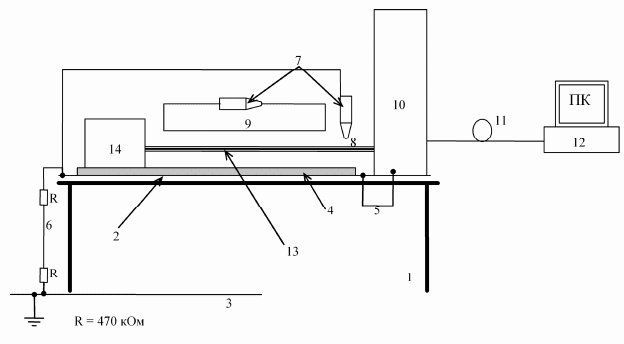
437
ЭКСПЕРИМЕНТАЛЬНОЕ ИССЛЕДОВАНИЕ УРОВНЕЙ ПОМЕХ В
БОРТОВОЙ КАБЕЛЬНОЙ СЕТИ ОТ ЭСР ДЛЯ ОБЕСПЕЧЕНИЯ
ФУНКЦИОНИРОВАНИЯ СИСТЕМ КОСМИЧЕСКОГО АППАРАТА
А.
И.
М
АЛИСТИН
,
Р
ОССИЯ
,
М.
В.
М
АРЧЕНКО
,
Р
ОССИЯ
ФГУП «Московское опытно-конструкторское бюро «Марс», e-mail: mokb-mars@mtu-net.ru
Аннотация. Описана конструкция стенда и методика проведения экспериментально исследования
уровней помех в бортовой кабельной сети космического аппарата от электростатического разряда.
Приведены уровни помеховых сигналов и рекомендации по испытаниям бортовых систем космиче-
ских аппаратов.
Abstract. Describe the construction of the stand and method of experimental investigation interference lev-
els in the spacecraft onboard cable network from electrostatic discharge. Shows the levels of interference
signals and recommendations for testing spacecraft onboard systems.
Измерение сигналов помех от электростатических
разрядов (ЭСР) – сложная инженерная задача. Электро-
статический разряд помимо создания мощного элек-
тромагнитного импульса и кондуктивного разрядного
тока сопровождается многократным переизлучением
электромагнитной энергии, в частности и на измери-
тельные цепи регистрирующей аппаратуры. Для кор-
ректного измерения сигналов помех от ЭСР требуется
установка с очень хорошей экранировкой, а так же на-
личие гальванической развязки цепей измерительной
установки от цепей остального оборудования.
Соответствующее оборудование было разрабо-
тано и изготовлено в МОКБ «Марс» - испытатель-
ный стенд камера Фарадея. Камера представляет со-
бой замкнутый металлический объем, в крышке ко-
торого выполнено окно со сменными панелями, для
установки различных разъемов Распайка разъема
сменной панели повторяет распайку блочного разъе-
ма, к которому в рабочем режиме пристыковывается
испытуемый кабель. Внутри камеры Фарадея разме-
щается четырехканальный осциллограф TDS 2024B,
входы которого коаксиальными кабелями подключе-
ны к соответствующим контактам разъема сменной
панели. Там же размещается источник бесперебой-
ного питания, обеспечивающий автономную работу
осциллографа в течение полутора часов. Управление
осциллографом и прием осциллограмм осуществля-
ется от удаленного компьютера по цифровому воло-
конно-оптическому кабелю. Вследствие принятых
мер наводки на открытый разъем камеры Фарадея
при воздействии на ее корпус контактного ЭСР на-
пряжением 20 кВ не превышают 5 мВ.
Испытательный стенд представляет собой камеру
Фарадея, установленную на проводящей поверхности и
имитатор бортового устройства – замкнутая металли-
ческая коробка объемом 1 дм
3
с разъемом для подклю-
чения второго конца испытуемого кабеля, соединенные
в испытательную схему в соответствии с рис.1.
Рис. 1. Схема измерений уровней помеховых сигналов при воздействии ЭСР.
1 – диэлектрический стол; 2 – плоскость связи; 3 – шина заземления; 4 –диэлектрическая прокладка; 5 –
перемычка металлизации; 6 – проводник соединяющий плоскость связи с шиной заземления через 2 резистора
470 кОм [1]; 7 – генератор ЭСР; 8 – место воздействия ЭСР на испытываемые кабель и разъем; 9 –токовый ин-
дуктор; 10 – камера Фарадея, 11 – оптоволоконный кабель передачи сигналов измерительной информации, 12 –
удаленное рабочее место; 13 – испытываемый кабель; 14 – имитатор бортового устройства.
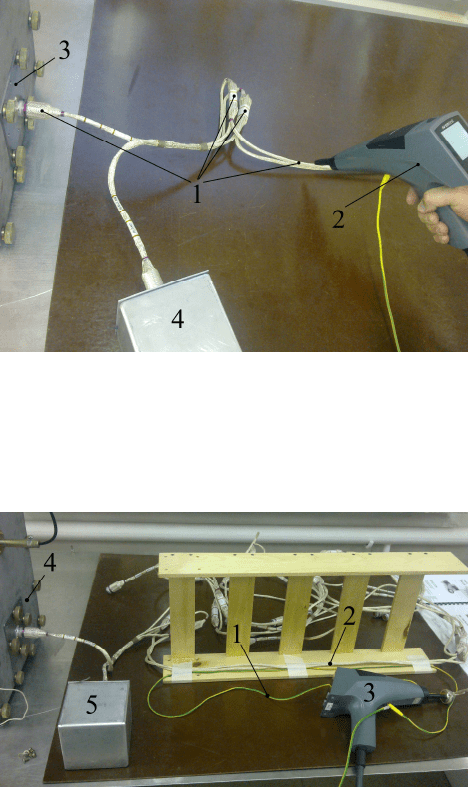
438
Основные этапы разработанной методики про-
ведения испытаний:
- Выбирается испытуемый кабель (13);
- На сменной панели камеры Фарадея (10) и имита-
торе бортовых устройств (14) устанавливаются
разъемы, являющиеся ответными по отношению
к разъемам испытуемого кабеля (13);
- На соответствующие контакты разъемов распаи-
ваются нагрузки, эквивалентные реальным;
- Испытываемый кабель размещается на диэлек-
трической поверхности (4) над проводящей по-
верхностью [1] испытательного стенда (2) и под-
ключается к входному разъему камеры Фарадея
и имитатора бортовых устройств;
- С управляющего компьютера (12) по цифровой
волоконной линии связи (11) в осциллограф за-
гружаются установочные данные: развертка, ко-
эффициенты отклонения по каждому каналу, ка-
нал запуска, измерение амплитуд сигналов и т.д.
- С управляющего компьютера осциллограф пере-
водится в ждущий режим;
- В выбранную точку испытуемого кабеля (8) с
помощью генератора электростатических разря-
дов ESD 30N (7) с разрядной цепью 150 Ом, 1000
пФ осуществляется электростатический разряд
(рис.2);
- На расстоянии нескольких сантиметров от испы-
туемого кабеля параллельно ему укладывается
провод токового индуктора (9) длиной ~ 1 м[2].
Концы провода подключаются к генератору ЭСР
(7);
- В контуре токового индуктора с помощью гене-
ратора электростатических разрядов ESD 30N с
разрядной цепью 150 Ом, 1000 пФ создается им-
пульсный ток безыскрового электростатического
разряда (рис.3);
- Осциллограммы наведенных помеховых сигналов
на внутренних проводниках кабеля сохраняются в
памяти компьютера.
- Повторяя описанные операции для различных
точек на испытуемом кабеле и для различных ка-
белей, определяются уровни помеховых сигна-
лов, формируемых во внутренних цепях испыты-
ваемых кабелей.
Для проведения натурных испытаний бортовая
кабельная сеть космического аппарата была разделе-
на на следующие группы:
1. Кабели цифровых последовательные шин –
выполнены экранированной витой парой, минималь-
ные используемые уровни цифрового сигнала 5 В;
2. Кабели аналоговых именительных цепей –
исполнение экранированное;
3. Кабели системы электроснабжения – экраниро-
ванные двухпроводные линии, постоянный ток 27В.
Рис. 2. Имитация ЭСР на испытываемый кабель.
1 – места воздействия искровым и безыскровым кон-
тактными ЭСР на испытываемый кабель; 2 – генера-
тор ESD 30N; 3 – камера Фарадея; 4 – имитатор бор-
тового устройства.
Рис. 3. Испытания кабеля с помощью
токового индуктора.
1 – токовый индуктор, подключенный
к генератору ЭСР; 2 – испытываемый образец;
3 – генератор ESD 30N; 4 – камера Фарадея;
5 – имитатор бортового устройства.
Разделение на группы необходимо для умень-
шения числа испытываемых образцов. Результаты из-
мерений уровней помеховых сигналов, возникающих в
разных группах кабелей бортовой кабельной сети сис-
темы управления космического аппарата KazSat-2 при
воздействии ЭСР, приведены в таблице 1.

439
Таблица 1 Результаты измерений уровней помеховых сигналов
Группа кабелей Тип воздействия
Максимальная ам-
плитуда помехового
сигнала в кабеле
Контактный искровой разряд (воздушный).
Амплитуда 20 кВ
110 мВ
Контактный разряд
Амплитуда 20 кВ
300 мВ
Группа 1:
Кабели цифровой последо-
вательной шины обмена
Воздействие импульсным полем через провод-
индуктор (бесконтактный безыскровой разряд в
контуре 20 кВ).
312 мВ
Группа 2:
Кабели аналоговых имени-
тельных цепей
Контактный разряд
Амплитуда 20 кВ
1 В
Группа 3:
Кабели системы электро-
снабжения
Контактный разряд
Амплитуда 20 кВ
1 В
Если не принять специальных мер по каче-
ственному экранированию кабельной сети, электро-
статические разряды, происходящие на борту косми-
ческого аппарата, могут вызывать помеховые сигна-
лы большой амплитуды и кроме мгновенных отка-
зов, могут приводить к отложенным отказам, т.е.
снижению времени безотказной работы элементов. В
этом случае, при проведении наземных стендовых
испытаний космических аппаратов возможны либо
выход из строя оборудования, либо возникновение
отложенных отказов, которые не могут быть выявле-
ны непосредственно в процессе испытаний. Исходя
из этого, рекомендуется проверку устойчивости бор-
товых систем начинать с испытания кабельной сети
и проводить в следующей последовательности:
1. Определить уровни помеховых сигналов при
воздействии ЭСР на кабели подсистемы космическо-
го аппарата нагруженные на имитаторы блоков. В
случае превышения допустимого уровня необходимо
принять меры к снижению величины помеховых
сигналов.
2. Определить уровни помеховых сигналов в це-
пях собранной системы (например, цепи контроля
стыковки и др.) при воздействии ЭСР на выключен-
ную бортовую систему.
3. Подтвердить обеспечение качества функцио-
нирования работающей бортовой системы при воз-
действии ЭСР.
Заключение.
Разработанный стенд для экспериментального
исследования уровней помех в бортовой кабельной
сети от ЭСР позволил получить амплитудные значе-
ния импульсных наводок в бортовых кабелях косми-
ческого аппарата и дать рекомендации по исследова-
нию устойчивости подсистем космического аппара-
та.
Литература:
1. ГОСТ Р 51317.4.2-99 Совместимость техниче-
ских средств электромагнитная. Устойчивость к
электростатическим разрядам. Требования и методы
испытаний. – Введ. 1999–24–14. – М.: Госстандарт
России, 2001 – 20с.
2. ECSS-E-ST-20-07C Space engineering. Electro-
magnetic compatibility. ECSS Secretariat. ESA-ESTEC.
Requirements & Standards Division. The Netherlands. –
2008. – Р. 89.

440
EXPERIMENTAL INVESTIGATION OF INTERFERENCE LEVELS IN THE
ONBOARD CABLE NETWORK FROM ESD TO ENSURE THE
FUNCTIONING OF SYSTEMS OF THE SPACECRAFT
A.
L.
M
ALISTIN
,
R
USSIA
,
M.
V.
M
ARCHENKO
,
R
USSIA
Moscow experimental constructor-design’s company “Mars”, e-mail: mokb-mars@mtu-net.ru
Abstract.
In the paper a construction of the stand and a method of experimental investigation of interference
levels in the spacecraft onboard cable network from electrostatic discharge are described. The levels of inter-
ference signals and recommendations for testing the spacecraft onboard systems are mentioned.
Measurement of interfering signals from electro-
static discharge (ESD) – a complicated engineering task.
Electrostatic discharge in addition to creating a powerful
electromagnetic pulse and conduction of the discharge
current is accompanied by multiple re-emission of elec-
tromagnetic energy, in particular, and the measuring
circuit detecting apparatus. For the correct measurement
of interfering signals from ESD requires a very good
screening, as well as the presence of electrical isolation
circuits measuring equipment from the chains of the re-
maining equipment.
Appropriate equipment was designed and manufac-
tured in the MOKB Mars - test stand chamber Faraday.
The chamber is a closed metal volume in the lid which
holds a window with removable panels for installation of
various connectors. The pinout connector of an access
panel repeats the real device. Inside the chamber Faraday
placed four channel storage oscilloscope, whose inputs
are connected via coaxial cable to the corresponding
connector contacts removable panel. In the same placed
uninterruptible power supply for autonomous operation
of the oscilloscope for a half hour. Remote control oscil-
loscope and reception waveforms provided from a re-
mote computer through a digital fiber-optic cable. As a
result measures taken to an open pickup connector
chamber Faraday impact on her body contact 20 kV ESD
shall not exceed 5 mV.
The test stand is a Faraday chamber, mounted on a
conducting plate and onboard simulator device - a closed
metal box with volume 1 dm
3
with a connector for the
second end of the test cable connected to the test circuit.
For a full-scale testing onboard cable network
spacecraft was divided into groups. The division into
groups is necessary to reduce the number of test samples.
The results of measurements of levels of interference
signals arising in different groups of cables onboard ca-
ble network control system of the spacecraft KazSat-2
under the influence of ESD are presented in Table 1.
During ground bench testing spacecraft recommend
checking the stability of the systems on board to begin
with testing the cable network, and a final test on-board
systems off and turned on state.
Table 1. Results of measurements of levels of interference signals.
Cable Group Type of influence
Amplitude interference
signal in the cable
Contact spark discharge (air discharge)
Amplitude of 20 kV
110 mV
Contact discharge
Amplitude of 20 kV
300 mV
Group 1:
Cables digital serial bus exchange
The impact of pulsed field through a wire-inductor
(non-contact non-sparking discharge in the circuit
20 kV).
312 mV
Group 2:
Cables nominatives analog chains
Contact discharge
Amplitude of 20 kV
1 V
Group 3:
Cables power supply system
Contact discharge
Amplitude of 20 kV
1 V
